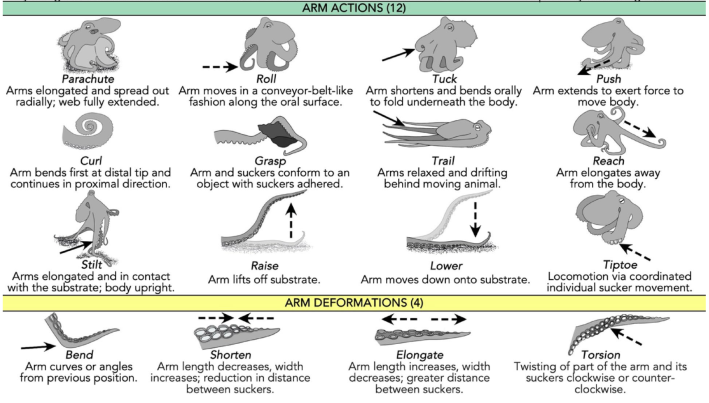Anyone with a paltry two arms is probably familiar with handedness, our predisposition to use either the left or right hand for particular tasks. (No ambidexterity erasure intended; you are valid!) But if you have the privilege of owning eight arms, how do you decide which arm to use? Can you even be left- or right-handed, or would you be third- or sixth-handed? Prior research suggested that octopuses were handed just like us, preferring to reach with either their left or right arms. But these experiments took place in the lab and focused on one or two arm movements, according to Kendra Buresch, a biologist at the Marine Biological Laboratory in Woods Hole. So Buresch and her colleagues began wondering how octopuses used their arms in the wild.
Their resulting report on how the cephalopods deploy their eight arms was recently published in in Scientific Reports, and it functions as a kind of glossary of the many capabilities of their powerful, suckered arms. Surprisingly, the scientists discovered that octopuses have no preferences between their left and right arms. Instead, the animals have something akin to a front and back preference, using their front four arms for exploration and the back for four movement.
The paper's other two authors—Chelsea Bennice, a marine biologist at Florida Atlantic University in Boca Raton, and Roger Hanlon, an ethologist and marine biologist at the Marine Biological Laboratory—have both studied octopuses in the wild. It can take hours to find wild octopuses, which are famously good at disguising themselves. "It's always tricky locating these animals that are masters of camouflage, but after several years, I got the hang of it," Bennice wrote in an email. These long dives offer researchers their best chance at observing the animals under natural conditions, away from the distractions of a laboratory setting. "Fieldwork is key to cataloging the full and natural range of capabilities that animals have," Hanlon wrote in an email.
They compiled footage of 25 octopuses taken over eight years of scuba diving across six field sites, which represented a range of habitats, including coral, sand, seagrass, rock, and rubble. "Octopuses are known to use specific behaviors on different habitat types," Bennice said.
After analyzing the videos, the researchers determined four ways that an octopus's arm can move. It can bend, curving into an angle. It can shorten, decreasing the distance between suckers, or elongate, increasing the distance between suckers. Or the arm can twist, making its suckers spiral around the arm. Then the researchers developed a visual key of what they determined to be 12 basic arm actions. These actions include parachute (in which the octopus's arms elongate and fan out, unfurling the webbing between arms), grasp (in which the arm and suckers wrap around an object), and stilt (in which the arm elongates to touch the substrate.)
If this sounds overwhelming, it gets even more complex. The researchers found that octopuses can perform multiple movements simultaneously on a single arm, as well as coordinate movements across different arms.

Octopuses combine their repertoire of arm actions to perform different behaviors and modes of locomotion, allowing the animals to navigate their environment and forage more efficiently. "Because they are such tactile creatures, they have evolved suckers and arms that not only give them many forms of locomotion, but sensory capabilities that allow them to find hidden foods," Hanlon said. Why only swim when you can also stand, or even walk?
The hours of footage also revealed that every single one of an octopus's arms can perform all four movements and 12 behaviors. Buresch was surprised by this total lack of specialization, adding that this highlighted the creatures' adaptability. Eight equally powerful arms offer an octopus a helpful layer of redundancy should one arm be lost—torn off by a predator or otherwise damaged. "No other animals are capable of such extreme arm flexibility and control," Bennice said.
The authors found that the octopuses used their front arms more frequently across all behaviors, with the exception of stilt and roll (in which an arm moves like a conveyor belt). Roll can be seen below, as an octopus performs "moving rock"—walking with its arms tucked under its body to appear like, well, a moving rock.
Though certainly wily, octopuses are soft and scrumptious to many other creatures on the reef. So being able to multitask with each arm offers them an edge on their quest to snag prey and drag it back to the safety of their den, as well as defend themselves against any rival octopuses.
The footage captured several species, including the common octopus and a similarly-sized species found in waters off Brazil. But the researchers wondered how these arm movements and behaviors might differ in an octopus of a different shape, such as the mimic Lilliput longarm octopus, a cephalopod with startlingly noodle-like arms. And scientists still have much to learn about the muscular arrangements and neural mechanisms that control how octopuses move and use their arms. Until then, just remember that anything you do, an octopus could probably do better, with seven arms tied behind its back.






